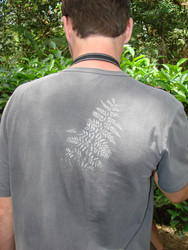
The farina covering the underside of some species of Pteridaceae (Pityrogramma calomelanos in this case) can be used, with a vigorous slap, to add attractive (temporary) designs to t-shirts. We thank our model, Joao Paulo Condack, for his partially informed participation. © 2008 Amanda Grusz
This page provides a short overview of farinose ferns. The majority of these ferns are cheilanthoids. The genera listed below are those that have species with the underside of their leaves densely covered with a layer of farina, a wax-like flavonoid deposit. Other taxa, including members of Pellaea, Cryptogramma, etc., may also produce farina, but in restricted locations, such as nestled among the sporangia. In brackets following the genus names is a short description of their phylogenetic affinities.
- Argyrochosma (cheilanthoids: pellaeids). This exclusively New World genus is superficially similar to some species of Notholaena. Its members have highly divided, relatively thick leaves, often with a flexuous, zig-zag rachis. They differ from the highly dissected Notholaena species in the following characters: the sporangia extend somewhat along the veins (vs. being confined to the vein tips); the rhizome scales are uniformly tan or brown (vs. uniformly dark or bicolored with a dark central stripe); and the gametophytes are glabrous (vs. farinose).
- Cheilanthes (cheilanthoids: hemionitids). The farinose species of Cheilanthes (including taxa sometimes recognized in the segregate genera Argyrochosma, Negripteris, Sinopteris, etc.) are predominantly Old World in distribution with only a single species (C. farinosa) occurring in the New World. Farinose Cheilanthes species tend to have wide lanceolate or triangular leaves, often with attenuate tips, dense white farina beneath, a prominent, membranous false indusium (vs. Notholaena and Argyrochosma), and sporangia confined to vein-ends (vs. Pentagramma and Pityrogramma).
- Notholaena (cheilanthoids: notholaenids). Notholaena is an entirely New World genus, with its center of diversity in the xeric habitats of Mexico. Its members have dense white, cream, or yellow farina, a weakly or undifferentiated fertile leaf margin (vs. Cheilanthes), and sporangia confined to the tips of the veins near the leaf margin (vs. Pentagramma and Pityrogramma). The Notholaena species with highly divided leaves are superficially similar to some species of Argyrochosma—see the latter genus for distinguishing characteristics.
- Pentagramma (cheilanthoids: hemionitids). Pentagramma is a small genus limited to the western side of the United State and Canada and extreme northwestern Mexico (Baja California; Yatskievych et al., 1990). The pentagonal leaf shape, small size, and geographic range distinguishes species of Pentagramma from Pityrogramma, a pteridoid genus in which they were previously placed (Yatskievych et al., 1990). Sporangial distribution (spread along the veins across the underside of the leaves) distinguishes them from all other farinose cheilanthoids.
- Pityrogramma (pteridoids). Pityrogramma is a genus of approximately 20 species, mostly of the New World tropics. They are less dependent on xeric habitats than most of the other farinose groups, and can often be rather weedy—occurring both in disturbed habitats and as human-introduced species far beyond their natural range. They are often larger ferns (leaves approaching 1 m long), with pinnately-divided leaves with dense white or yellow farina beneath. They are distinguished from Pentagramma by the characters given under that genus, and from all other farinose ferns by their sporangia, which are distributed along the veins beneath the leaves.




 Go to quick links
Go to quick search
Go to navigation for this section of the ToL site
Go to detailed links for the ToL site
Go to quick links
Go to quick search
Go to navigation for this section of the ToL site
Go to detailed links for the ToL site